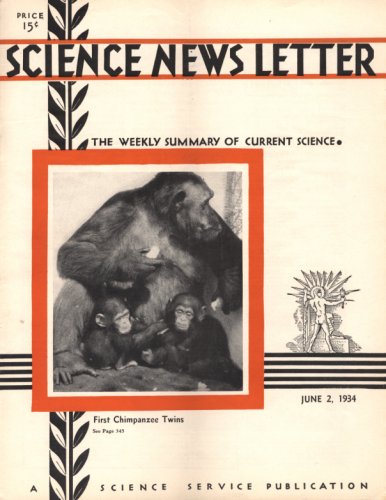From the June 2, 1934, issue

FIRST CHIMPANZEE TWINS PICTURED WITH MOTHER
The first chimpanzee twins born in captivity, and the first occurrence of such a double birth among the great apes for which there is any scientific record, was reported recently by Dr. Robert M. Yerkes of the Laboratories of Comparative Psychobiology, Yale University.
A camera was trained on the rare infants by M.I. Tomilin, of Dr. Yerkes’ staff, obtaining the very excellent portrait shown on the cover of this week’s Science News Letter.
The twins were born at the Anthropoid Experiment Station in Orange Park, Florida. When photographed they were exactly 4 months and 1 day old.
HIGHER SPEEDS FOR AIRPLANES AND GREATER SAFETY FORESEEN
Still greater airplane speeds and added safety and economy for private, transport, and military planes are foreseen as the result of research conducted during the past year at Langley Field, Va., by the National Advisory Committee for Aeronautics.
In the past 4 years, as a direct result of NACA research applied by manufacturers, airplanes have had their speeds boosted by 75 miles per hour with no increased power required. Now, airplane designers and manufacturers making their annual visit to the NACA laboratories here learned of new researches that seem likely to give another spurt to improved airplane design.
Some of the possibilities are:
New methods of lateral control replacing ailerons, which have been standard for 25 years, will greatly accelerate the use of airplanes by private pilots. The most promising are flaps called spoilers, which when raised lengthwise above the wings by the pulling of a lever, will allow shorter take-offs and shorter safe landings by relatively unskilled fliers.
Through the simple device of making one seemingly insignificant part of a seaplane float pointed instead of square, flying boats carrying 50 passengers across the Atlantic are foreseen. The new float proved its worth in the NACA world’s largest towing basin, at Langley Field, Va.
Autogiros are capable of flying 200 miles per hour, wind tunnel tests show, whereas last year it was generally agreed that this “vertical windmill” type of aircraft, radically different from the airplane, would be useful only for slow speeds.
NEW ACID INDICATOR MAY BE BETTER THAN LITMUS
Chemistry has been presented with a new chemical that is said to have advantages over litmus for indicating the difference between acid solutions and alkaline solutions at very low concentrations.
It is 2,4-dinitrobenzene-azo-1-naphthol-3,6-disulfonic acid, a name that tells the chemist exactly what it is composed of, but the inventor has offered “nitrazine yellow” as a shorter alternative.
Nitrazine yellow is distinctly blue in a solution of alkali such as soap or ammonia. If an acid like muriatic or vinegar is added, the solution remains blue until the alkali is neutralized. Then, if a little more acid is added the solution turns gray, at an extremely low acid concentration defined by chemists as pH 6.6, and beyond that point on a rising acid concentration the nitrazine yellow in the solution turns bright yellow.







